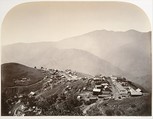The Town on the Hill, New Almaden
Carleton E. Watkins American
Not on view
Watkins, the consummate photographer of the American West, combined a virtuoso mastery of the difficult wet-plate negative process with a rigorous sense of pictorial structure. In 1863 he was hired to make a photographic survey of the quicksilver mining operations in New Almaden, near San Jose, California. Quicksilver—used to bond with, and weigh down, the finest particles of gold that might otherwise float away in the sluicing process—was essential to the gold-mining industry, and the mining of quicksilver itself became a profitable enterprise.
Watkins's clients hoped to use his photographs to convince potential investors of the promise of the New Almaden site. To this end Watkins made numerous stereographic views documenting minute details of the mining process as well as mammoth views that were meant to show the town to its best possible advantage. Capitalizing on the calm of the hazy early morning and a picturesque vantage point, Watkins portrayed the mining camp as a charming mountain village possessing an appealing tidiness and an air of perfect tranquility.
Due to rights restrictions, this image cannot be enlarged, viewed at full screen, or downloaded.

